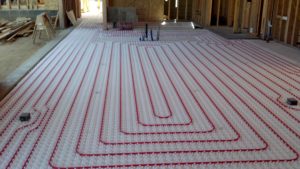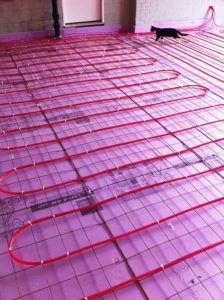 A1 Advanced Energy Solutions provides top of the line radiant heating in Knoxville, TN and surrounding areas. Radiant heating systems deliver heat through a building’s floors or walls, warming adjacent air only indirectly. Radiant heating systems are most effective as indoor heat sources, either in a localized area (such as a bathroom) or an entire home. However, some businesses (often restaurants or entertainment venues) and upscale homes use radiant heat to warm patios and other outdoor spaces.
A1 Advanced Energy Solutions provides top of the line radiant heating in Knoxville, TN and surrounding areas. Radiant heating systems deliver heat through a building’s floors or walls, warming adjacent air only indirectly. Radiant heating systems are most effective as indoor heat sources, either in a localized area (such as a bathroom) or an entire home. However, some businesses (often restaurants or entertainment venues) and upscale homes use radiant heat to warm patios and other outdoor spaces.
5 Benefits of Radiant Heating
Potential for Lower Utility Bills
Radiant heating systems – particularly hydronic systems – often lower utility bills relative to sources of heat, such as forced air and steam. Hydronic floor heating systems are up to 30% more efficient than forced-air systems.
Water conducts heat more effectively than air, which quickly loses heat without a constant source. That means less energy is required to maintain water at a particular temperature over time.
Hydronic systems also deliver heat directly to solid surfaces that are even better than water at conducting heat, such as wood or tile flooring and wall paneling. Since heat transfer between the heated water and solid surfaces is more efficient than, say, heat transfer between steam and air or an electric radiator and the air, the water supply of a hydronic system can be maintained at a lower temperature than other heat distribution media.
No Ductwork
Radiant heating systems don’t require ductwork to function properly. And if your home doesn’t have a central air conditioning system, it doesn’t need ducts at all.
Knoxville, TN homeowners without ducts have one less piece of infrastructure to maintain – and one less budgetary line item to worry about. High-quality duct cleaning services can cost $300 to $500, and are recommended once every other year for homes with heavily used HVAC systems.
Even if you do have a central air conditioning system, you probably don’t need to use it all year long. Ducts that aren’t used for much of the year wear more slowly and don’t require heavy maintenance.
More Floor Space/No Registers or Vents
Aside from the boiler and possibly zoning valves, radiant heating systems don’t have any visible components. Most other commonly used heat distribution systems have registers, vents, baseboards, radiators, or other visible components that take up floor space in a home’s living area and reduce the amount of square footage available for decorations, furniture, storage, and other usage.
These system components also require varying degrees of maintenance and cleaning – particularly registers and baseboards, which are magnets for dust and pet hair.
Better Indoor Air Quality
Forced-air heating systems continuously circulate air through a home’s ducts and registers, quickly distributing pet dander, dust, mold spores, and other allergens throughout the structure. By contrast, radiant heating systems don’t circulate air at all, and thus don’t keep allergens airborne as long as forced-air systems. That means better indoor air quality – a particularly important consideration for adults and children with allergies, asthma, and other conditions that can be exacerbated by indoor pollution.
Uniform Vertical Heat Distribution
Most heating systems deliver heat into a room from a focused point, such as a forced-air vent or steam radiator, or a single side, such as a baseboard radiator. The adjacent area is typically the warmest place in the room.
However, as the heated air or steam enters the room, it almost immediately begins to rise towards the ceiling, and only falls after losing much of its heat. That makes the air near the floor noticeably colder – 20 degrees or more – than the air at head level, five or six feet above the ground. The result: cold feet and hot heads. This effect is more pronounced in homes without excellent insulation and when it’s very cold outside.
By contrast, radiant heating systems slowly heat rooms from the floors up, from the walls in, or both. The heated surfaces warm adjacent air at a relatively low temperature, transferring heat to other parts of the room at a uniform rate. This means less noticeable temperature contrasts within rooms, little to no vertical temperature stratification, and more comfortable rooms overall.
Conclusion
As you can see, a radiant heating system for your Knoxville, TN home has many benefits over conventional heating systems. A1 Advanced Energy Solutions has the experience and technology to ensure you have the best radiant heating system for your home. Give us a call today for more information.
865.216.2460
About A1 Advanced Energy Solutions
 A-1 Advanced Energy Solutions has provided Knoxville, TN with residential & commercial plumbing solutions, hot water systems, tank & tankless water systems, sewer line repair and installs, hydronic radiant floor heating systems, drain cleaning, solar water heating, and more. A-1 Advanced Energy Solutions has been working with Knoxville, TN residents for over 20 years and we have built a strong reputation for quality work at a fair price.
A-1 Advanced Energy Solutions has provided Knoxville, TN with residential & commercial plumbing solutions, hot water systems, tank & tankless water systems, sewer line repair and installs, hydronic radiant floor heating systems, drain cleaning, solar water heating, and more. A-1 Advanced Energy Solutions has been working with Knoxville, TN residents for over 20 years and we have built a strong reputation for quality work at a fair price.
A-1 also has specialized experience in High Energy Hydronic heating systems, but also provide tankless water heating installations and service, solar water heating for preheating and space heating, and wood burning stoves for heat throughout your entire home.
We work on new or remodel repairs on commercial or residential locations, and are available to service old water services lines or install new ones. For your sewers, we can install new sewer services or preform sewer line inspections and cleaning.
Call A-1 Advanced Energy Solutions today for all of your radiant heating and plumbing needs:
865.216.2460


